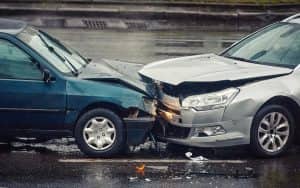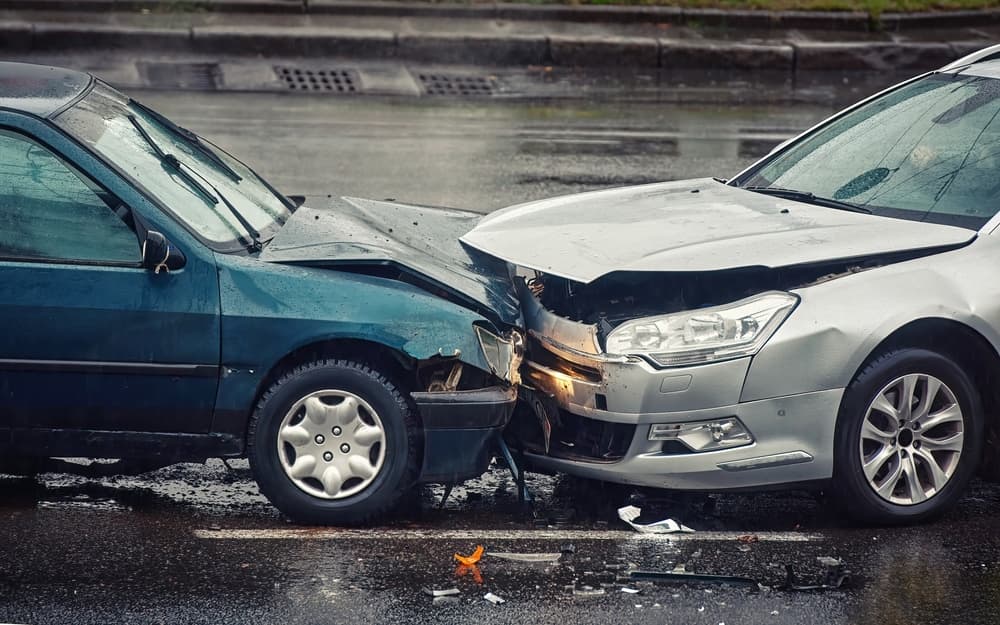Head-on car collisions are some of the worst kinds of traffic accidents people can endure. Collisions with frontal impact often lead to devastating consequences, life-threatening injuries, and lasting trauma. This is because when two cars collide face to face, there is nowhere for the vehicle’s energy to go except into the other vehicle.
Vehicle occupants involved in head-on collisions can suffer debilitating or fatal injuries even with airbags, seatbelts, and other safety features. Of all deaths in crashes with other vehicles, head-on collisions accounted for nearly 30 percent of them.
Following a frontal impact crash, the cost of medical care can become highly burdensome and is likely to eat into your family’s savings. If you suffered injuries or your loved one died in a head-on collision due to someone else’s negligence, you might have a right to seek compensation by filing an insurance claim or suing the negligent party with the assistance of a skilled Las Vegas car accident lawyer for personal injury or wrongful death.
Causes of Head-On Car Collisions
A head-on collision is when two cars strike each other from the front. This type of accident usually occurs when two vehicles travel in opposite directions. Because the two cars meet face-to-face, these collisions produce substantial force. While the hoods of the vehicles are designed to absorb much of the force generated by a frontal impact, vehicle occupants are still very likely to suffer multiple types of catastrophic injuries.
In most cases, head-on car collisions occur because of the negligent or reckless actions of one of the drivers. Among the most common causes are:

- Driving while intoxicated. Driving under the influence of drugs or alcohol is one of the leading – and inexcusable – causes of head-on collisions. When a driver is impaired, it becomes difficult to judge distances and time, which may cause them to swerve into the opposite lane and collide with vehicles from oncoming traffic. Drinking and driving is not only illegal and dangerous, but it can also be fatal. In a recent year, nearly 13,400 deaths on the road involved drunk driving.
- Distracted driving. When drivers take their eyes off the road, their hands off the wheel, or their minds off driving, they automatically make themselves prone to accidents. This can happen when the driver is texting, talking on the phone, or even just changing the radio station or taking a sip of coffee. To avoid this, drivers should stay focused and avoid any behavior that distracts them from driving.
- Passing improperly. Unlawfully passing another vehicle is another common cause of head-on car accidents. When drivers try to pass other vehicles without having clear visibility, they increase the likelihood of crashing into vehicles traveling in the opposing direction. To avoid this scenario, all drivers should obey road signs and ensure no oncoming traffic is nearby before passing another vehicle.
- Wrong-way driving. Driving against the intended flow of traffic is dangerous because other drivers may not expect another vehicle to come from the opposite direction and may not have enough time to react to avoid a collision.
- Fatigued driving. Tired or sleepy drivers often experience difficulty focusing, which may cause a lapse in judgment and result in poor decision-making. That is why drivers should take regular breaks when driving long distances and avoid getting behind the wheel while fatigued or excessively sleepy.
- Reckless driving. Driving with excessive speeds, weaving, and improper lane change are some of the most common reckless driving behaviors, reducing reaction time and increasing the likelihood of frontal impact collisions.
- Speeding around curves. Speeding around bends on the road also significantly contributes to accidents in which vehicles collide head-on. This often happens when drivers underestimate a curve’s sharpness or speed limits or overestimate their vehicle’s abilities to accelerate, and, as a result, they can collide with oncoming traffic. This is particularly dangerous on narrow roads and hilly terrain, with limited visibility.
- Failing to adjust to poor weather. Poor weather conditions can cause slippery roads, poor visibility, and other hazardous driving situations. Drivers should reduce speed, increase space between vehicles, and be mindful of their surroundings during poor weather. If they don’t, they may cross over the centerline into the oncoming travel lane.
Operating a motor vehicle is a privileged activity that comes with a great deal of responsibility and accountability. To stay safe on the road, drivers should always obey traffic rules, stay alert, maintain their vehicles, and remain aware of their surroundings. When drivers fail to take preventative measures, they put themselves and everyone else on the road at risk.
The Dangers of Head-On Collisions
Head-on collisions are the most terrifying and dangerous type of accidents on our roads because vehicle occupants are exposed to the following dangers:
Greater Kinetic Energy
When two cars collide head-on, the kinetic energy increases drastically, posing a severe danger to the people inside the vehicles. In a frontal impact crash, both vehicles come to an abrupt stop; the amount of kinetic energy the vehicles have left at that moment will determine the force of the impact. The more massive the vehicles and the higher the speed, the greater the kinetic energy involved, increasing the potential for catastrophic injuries and fatalities.
Flying Debris
Another danger of head-on collisions is the flying debris that results from the impact. Projectiles, including shattered glass, can cause severe injuries such as cuts, bruises, and even fractures. Depending on the speed and point of impact, the debris can be propelled to great distances from the initial crash point, posing a danger to other drivers and pedestrians.
Lack of Crumple Zones
Most modern cars have crumple zones designed to absorb the energy of an impact. However, head-on collisions pose a challenge as the impact can be too enormous for these zones to handle, leading to extensive damage and debilitating injuries. With older cars and trucks with inadequate safety features, occupants are at greater risk of injury following such a collision.
Increased Severity at High Speeds
Even at a lower speed impact, a head-on collision can be fatal. At a high speed, the collision is even more likely to lead to catastrophic injuries and fatalities. Remember, the faster you drive, the shorter your driver-reaction time. Speeding reduces your ability to control your vehicle, making it more difficult to steer and brake the vehicle to avoid a collision.
Limited Reaction Time
Depending on the oncoming vehicle’s speed and where it is coming from, there is often limited time to react and avoid a head-on collision. In most cases, the driver has less than two seconds to apply the brake or steer out of the way. Driving while distracted or impaired further limits reaction time and endangers everyone sharing the road.
Common Types of Injuries in Head-On Car Collisions
Due to the high speed at which the vehicles are traveling, the force of impact in a head-on collision can cause severe injuries that can be debilitating or even fatal. The following types of injuries are among the most commonly observed in collisions involving frontal impact:
- Head injuries. Vehicle occupants are likely to hit their heads during a head-on collision, which can result in concussions, skull fractures, or even brain damage. Symptoms of head injuries can vary, and sometimes, they can take time to develop. You should seek immediate medical attention if a brain or head injury is suspected, even if there are no signs of visible damage and no symptoms.
- Broken bones. Given the force of impact, it is common for passengers and drivers in a head-on collision to suffer from broken bones. The impact can cause fractures in different body parts, including arms, legs, ribs, and hips. Severe fractures may require surgery or extended recovery periods and can leave passengers with long-term complications.
- Internal organ damage. When the body is subjected to severe impact, internal organs, including the liver, kidneys, and spleen, can sustain serious damage. Injuries to internal organs can result in significant bleeding or require emergency surgeries to save the victim’s life.
- Spinal cord injuries. A head-on collision can also result in spinal cord injuries, which can have both serious and lasting effects. Depending on the severity of the injury, spinal cord injuries can lead to paralysis, loss of sensation, or even death.
- Blunt-force trauma. The impact of a collision can cause blunt-force trauma to a victim’s body. This can lead to life-threatening injuries to multiple parts of the body, including the abdomen and the chest.
- Loss of limb. A head-on collision may also lead to the loss of limbs, which can tremendously impact a person’s quality of life. Sometimes, the damage can be so severe that amputation is necessary.
- Chest injuries. Chest injuries from a head-on collision can include broken ribs, punctured lungs, and damage to the heart. These injuries can result in breathing problems or internal bleeding and require immediate medical attention.
- Facial injuries. Head-on collisions often result in severe facial injuries because a victim’s face is particularly vulnerable in this type of crash. Facial injuries, including broken jaws and nose, may require reconstructive surgery and cause disfigurement.
- Double-impact Injuries. When cars collide head-on, passengers can experience double-impact injuries. This happens when the body gets struck twice due to the forces exerted by the crashes. These injuries can be more severe and require longer recovery periods.
The injuries caused by these crashes can be life-changing, not to mention that head-on car collisions are the deadliest type of accident. Statistically speaking, frontal impacts account for nearly 60 percent percent of passenger vehicle occupant fatalities.
Frequently Asked Questions (FAQs) About Head-On Car Collisions

The aftermath of a head-on collision may be a very difficult and challenging time. You may not know what happens next or how to proceed with your claim for compensation. Also, chances are you have dozens of questions and are looking for answers. You might want to contact an experienced attorney for more details to ensure that you have an accurate assessment of your situation.
Where do head-on collisions happen?
Many head-on collisions occur on rural roads. Statistically speaking, 13 percent of all traffic fatalities on rural roads are head-on crashes. These accidents are disproportionately more common on undivided two-lane roads where drivers are often required to cross into oncoming traffic to pass slower-moving vehicles traveling in the same direction.
Who is at fault in a head-on car collision?
The driver who crosses the center line and causes a head-on collision is typically found at fault for the crash, though there may be exceptions in some cases. Establishing fault in this type of accident can be complicated and not always straightforward, so it is highly recommended that you seek legal advice to understand the specifics of your case.
What evidence do I need to prove that the other driver was at fault?
To prove fault, you will need all evidence available, such as police reports, witness statements, photos of the accident scene and vehicle damage, and any medical records related to your injuries after the accident. You need as much evidence as possible to bolster your claim, as memories can fade, and some pieces of evidence can be lost if not preserved.
I don’t have any visible injuries. Should I still see a doctor?
Yes, absolutely. Even if you do not have any visible injuries, you might still have suffered internal injuries that may not show up immediately, which is very likely in an accident as traumatizing as a head-on collision. Some injuries, such as concussions, may not be apparent until days or even weeks after the collision.
What compensation can I recover after a head-on collision?
The compensation you can recover depends on the specific circumstances of your case. In most cases, injured victims may be entitled to compensation for their medical bills, loss of income, property damage, loss of enjoyment of life, pain and suffering, and any other damages related to the accident. An experienced attorney can review the circumstances of your case and determine what compensation you deserve.
How can an attorney help me after a head-on car collision?
An attorney can support you in a variety of ways. Particularly, your attorney can gather evidence, determine fault, negotiate with insurance companies, and navigate every step of the legal process. When working with a Las Vegas personal injury attorney, they can provide you with compassionate guidance and valuable legal advice. At the same time, you can focus on getting better without the additional stress of dealing with the legal process looming over your head.
